Sustainable Bitumen Modification Using Bio-Based Adhesion Promoters
Abstract
1. Introduction
2. Materials and Methods
2.1. Materials
2.2. Methods
2.2.1. Obtaining Bio-Based Adhesion Promoters
2.2.2. Modification of Bitumen
2.2.3. Properties of Bitumen
2.2.4. Dynamic Shear Rheology
2.2.5. XRF Analysis
2.2.6. SEM/EDS Analysis
2.2.7. FTIR Analysis
3. Results and Discussion
3.1. Synthesis Bio-Based Adhesion Promoters
3.2. Modification of Bitumen with Bio-Based Adhesion Promoters
3.2.1. Physical and Mechanical Properties
3.2.2. Short-Term Aging Properties
3.2.3. Adhesion Properties
- (1)
- Before aging—more than 75%;
- (2)
- After RTFOT—more than 60%;
- (3)
- After TFOT—more than 65%.
3.2.4. Rheological Properties
3.2.5. Chemical Properties
4. Conclusions
- (1)
- Adhesion additives synthesized from rapeseed oil and higher fatty acids using polyethylene polyamine are effective in enhancing the adhesive properties of road bitumen. The incorporation of these bio-based additives at a concentration of 0.4 wt.% significantly improves the adhesion of bitumen to both glass and mineral aggregates without notably altering the physical and mechanical properties of the bitumen.
- (2)
- The additive derived from higher fatty acids improves the rheological performance of bitumen by increasing the |G*|/sin(δ) parameter and decreasing the phase angle (δ), indicating enhanced rutting resistance at elevated temperatures.
- (3)
- Infrared spectroscopy and acid value measurements confirmed that the fatty acid-based additive inhibits oxidative aging of bitumen by reducing the formation of S=O and C=O groups. This makes it a promising agent not only for improving adhesion but also for enhancing the aging resistance of bitumen.
- (4)
- Thermal stability testing revealed that the effectiveness of the adhesive additives decreases significantly after the simulated short-term aging. This suggests the need for further optimization of the synthesis process, particularly with regard to the ratio between the amine and acid components.
- (5)
- The findings confirm the potential of biodegradable adhesion additives—especially those based on higher fatty acids—as environmentally friendly modifiers that can improve bitumen performance and contribute to the durability of asphalt pavements.
Author Contributions
Funding
Institutional Review Board Statement
Informed Consent Statement
Data Availability Statement
Acknowledgments
Conflicts of Interest
Abbreviations
| AP | Adhesion promoter |
| AV | Acid value |
| CAI | Chemical aging index |
| FA | Fatty acids |
| FA-AP | Adhesion promoter is based on fatty acids |
| FTIR | Fourier-transform infrared spectroscopy |
| PEPA | Polyethylene polyamine |
| RO | Rapeseed oil |
| RO-AP | Adhesion promoter is based on rapeseed oil |
| SEM/EDS | Scanning electron microscopy/energy dispersive X-ray spectroscopy |
| XRF | X-ray fluorescence |
References
- Pstrowska, K.; Gunka, V.; Sidun, I.; Demchuk, Y.; Vytrykush, N.; Kułażyński, M.; Bratychak, M. Adhesion in bitumen/aggregate system: Adhesion mechanism and test methods. Coatings 2022, 12, 1934. [Google Scholar] [CrossRef]
- Airey, G.D.; Collop, A.C.; Zoorob, S.E.; Elliott, R.C. The influence of aggregate, filler and bitumen on asphalt mixture moisture damage. Constr. Build. Mater. 2008, 22, 2015–2024. [Google Scholar] [CrossRef]
- Ollendorf, H.; Schneider, D. A comparative study of adhesion test methods for hard coatings. Surf. Coat. Technol. 1999, 113, 86–102. [Google Scholar] [CrossRef]
- Canestrari, F.; Cardone, F.; Graziani, A.; Santagata, F.A.; Bahia, H.U. Adhesive and cohesive properties of asphalt-aggregate systems subjected to moisture damage. Road Mater. Pavement Des. 2010, 11, 11–32. [Google Scholar] [CrossRef]
- Zhang, J.; Apeagyei, A.K.; Airey, G.D.; Grenfell, J.R. Influence of aggregate mineralogical composition on water resistance of aggregate-bitumen adhesion. Int. J. Adhes. Adhes. 2015, 62, 45–54. [Google Scholar] [CrossRef]
- Zhou, L.; Huang, W.; Zhang, Y.; Lv, Q.; Yan, C.; Jiao, Y. Evaluation of the adhesion and healing properties of modified asphalt binders. Constr. Build. Mater. 2020, 251, 119026. [Google Scholar] [CrossRef]
- Remišová, E.; Holý, M. Changes of properties of bitumen binders by additives application. IOP Conf. Ser.: Mater. Sci. Eng. 2017, 245, 032003. [Google Scholar]
- Gunka, V.; Prysiazhnyi, Y.; Hrynchuk, Y.; Sidun, I.; Demchuk, Y.; Shyshchak, O.; Poliak, O.; Bratychak, M. Production of Bitumen Modified with Low-Molecular Organic Compounds from Petroleum Residues. 3. Tar Modified with Formaldehyde. Chem. Chem. Technol. 2021, 15, 608–620. [Google Scholar] [CrossRef]
- Gunka, V.; Astakhova, O.; Hrynchuk, Y.; Sidun, I.; Reutskyy, V.; Mirchuk, I.; Poliak, O. A Review of Road Bitumen Modification Methods. Part 1—Physical Modification. Chem. Chem. Technol. 2024, 18, 295–304. [Google Scholar] [CrossRef]
- Kohut, A.; Poliak, O.; Sidun, I.; Onyshchenko, A.; Besaha, K.; Gunka, V. A Review of Road Bitumen Modification Methods. Part 2—Chemical Modification. Chem. Chem. Technol. 2025, 19, 141–156. [Google Scholar] [CrossRef]
- Oliviero Rossi, C.; Teltayev, B.; Angelico, R. Adhesion promoters in bituminous road materials: A review. Appl. Sci. 2017, 7, 524. [Google Scholar] [CrossRef]
- Rossi, C.O.; Caputo, P.; Baldino, N.; Lupi, F.R.; Miriello, D.; Angelico, R. Effects of adhesion promoters on the contact angle of bitumen-aggregate interface. Int. J. Adhes. Adhes. 2016, 70, 297–303. [Google Scholar] [CrossRef]
- Dvorkin, L.; Marchuk, V.; Kuzlo, M. Influence of adhesive additives on the properties of bitumen and asphalt mixtures. Zast. Mater. 2024, 65, 668–679. [Google Scholar] [CrossRef]
- Alamrew, A.S.; Mollenhauer, K. Advantages of Filler and Surfactant Additive to Improve Moisture Sensitivity of Hot Mix Asphalt Mixtures. IOP Conf. Ser. Mater. Sci. Eng. 2021, 1202, 012011. [Google Scholar]
- Remišová, E. Improvement in properties of bitumen using selected additives. In Proceedings of the 5th International Conference on Road and Rail Infrastructure, Zadar, Croatia, 17–19 May 2018; Volume 5, pp. 17–19. [Google Scholar]
- Cihlářová, D.; Fencl, I.; Cápayová, S.; Pospíšil, P. Use of adhesion promoters in asphalt mixtures. Slovak. J. Civ. Eng. 2018, 26, 19. [Google Scholar] [CrossRef]
- Levin, J.O.; Andersson, K.; Hallgren, C. Exposure to low molecular polyamines during road paving. Ann. Occup. Hyg. 1994, 38, 257–264. [Google Scholar] [CrossRef]
- Yu, Q.; Liu, J.; Xia, H. Analysis of influence of surfactant on the properties of diluted asphalt mixtures. Case Stud. Constr. Mater. 2022, 17, e01335. [Google Scholar] [CrossRef]
- Mercado, R.A.; Salager, J.L.; Sadtler, V.; Marchal, P.; Choplin, L. Breaking of a cationic amine oil-in-water emulsion by pH increasing: Rheological monitoring to modelize asphalt emulsion rupture. Colloids Surf. A Physicochem. Eng. Asp. 2014, 458, 63–68. [Google Scholar] [CrossRef]
- Kakar, M.R.; Hamzah, M.O.; Akhtar, M.N.; Woodward, D. Surface free energy and moisture susceptibility evaluation of asphalt binders modified with surfactant-based chemical additive. J. Clean. Prod. 2016, 112, 2342–2353. [Google Scholar] [CrossRef]
- Bearsley, S.R.; Haverkamp, R.G. Adhesive properties of tall oil pitch modified bitumen. Road Mater. Pavement Des. 2007, 8, 449–465. [Google Scholar] [CrossRef]
- Cui, S.; Blackman, B.R.; Kinloch, A.J.; Taylor, A.C. Durability of asphalt mixtures: Effect of aggregate type and adhesion promoters. Int. J. Adhes. Adhes. 2014, 54, 100–111. [Google Scholar] [CrossRef]
- Starchevskyy, V.; Hrynchuk, Y.; Matcipura, P.; Reutskyy, V. Influence of initiators on the adhesion properties of bitumen modified by natural origin epoxide. Chem. Chem. Technol. 2021, 15, 142–147. [Google Scholar] [CrossRef]
- Guo, F.; Pei, J.; Zhang, J.; Xue, B.; Sun, G.; Li, R. Study on the adhesion property between asphalt binder and aggregate: A state-of-the-art review. Constr. Build. Mater. 2020, 256, 119474. [Google Scholar] [CrossRef]
- Woodhams, R.T. Ferric oxide adhesion promoters for water resistant asphalt pavements. J. Adhes. 1998, 68, 65–91. [Google Scholar] [CrossRef]
- Chariwala, A.; Patel, S.S.; Shaikh, M.M.; Tailor, S.A. A Study on Warm Mix Asphalt Technology on Bituminous Mixesusing Rediset-Wmx. IOSR J. Mech. Civ. Eng. 2016, 13, 15–25. [Google Scholar] [CrossRef]
- Jamshidi, A.; Golchin, B.; Hamzah, M.O.; Turner, P. Selection of type of warm mix asphalt additive based on the rheological properties of asphalt binders. J. Clean. Prod. 2015, 100, 89–106. [Google Scholar] [CrossRef]
- Oliveira, J.R.; Silva, H.M.; Abreu, L.P.; Fernandes, S.R. Use of a warm mix asphalt additive to reduce the production temperatures and to improve the performance of asphalt rubber mixtures. J. Clean. Prod. 2013, 41, 15–22. [Google Scholar] [CrossRef]
- Rossi, C.O.; Caputo, P.; Baldino, N.; Szerb, E.I.; Teltayev, B. Quantitative evaluation of organosilane-based adhesion promoter effect on bitumen-aggregate bond by contact angle test. Int. J. Adhes. Adhes. 2017, 72, 117–122. [Google Scholar] [CrossRef]
- Nadirov, R.; Ketegenov, T.; Batkal, A.; Kalugin, S.; Teltayev, B.; Caputo, P.; Rossi, C.O.; Kamunur, K.; Assylkhanov, Z.; Osserov, T. Sustainable adhesion additive improving road bitumen properties with rapeseed oil waste. Sustainability 2025, 17, 1472. [Google Scholar] [CrossRef]
- Lu, X.; Robertus, C.; Ostlund, J.A. Bituminous binders extended with a renewable plant-baised oil: Towards a carbon neutral bitumen. In Proceedings of the LJMU Highways and Airport Pavement Engineering, Asphalt Technology, and Infrastructure International Conference, Liverpool, UK, 11–12 March 2020; pp. 11–12. [Google Scholar]
- Abe, A.A.; Oliviero Rossi, C.; Caputo, P.; De Santo, M.P.; Godbert, N.; Aiello, I. Spicy bitumen: Curcumin effects on the rheological and adhesion properties of asphalt. Materials 2021, 14, 1622. [Google Scholar] [CrossRef] [PubMed]
- Abe, A.A.; Oliviero Rossi, C.; Caputo, P. Biomaterials and their potentialities as additives in bitumen technology: A review. Molecules 2022, 27, 8826. [Google Scholar] [CrossRef] [PubMed]
- Somé, S.C.; Gaudefroy, V.; Delaunay, D. Effect of vegetable oil additives on binder and mix properties: Laboratory and field investigation. Mater. Struct. 2016, 49, 2197–2208. [Google Scholar] [CrossRef]
- DSTU EN 12591:2017; Bitum and Bitumen Binders. Technical Requirements for Road Bitumen. State Standard of Ukraine (DSTU): Kyiv, Ukraine, 2017. Available online: https://online.budstandart.com/ua/catalog/doc-page.html?id_doc=72959 (accessed on 1 October 2017).
- DSTU EN 1426:2018; Bitumen and Bituminous Binders. Determination of the Depth of the Needle Permeability (Penetration). State Standard of Ukraine (DSTU): Kyiv, Ukraine, 2018. Available online: https://online.budstandart.com/ua/catalog/doc-page.html?id_doc=78299 (accessed on 1 June 2019).
- DSTU EN 1427:2018; Bitum and Bitumen Binders. Determination of Softening Temperature by Ring and Bullet Method. State Standard of Ukraine (DSTU): Kyiv, Ukraine, 2018. Available online: https://online.budstandart.com/ua/catalog/doc-page.html?id_doc=78301 (accessed on 1 June 2019).
- DSTU EN 12593:2018; Bitum and Bituminous Binders. Determination of the Crumbular Temperature by the Phraas Method. State Standard of Ukraine (DSTU): Kyiv, Ukraine, 2018. Available online: https://online.budstandart.com/ua/catalog/doc-page.html?id_doc=78305 (accessed on 1 June 2019).
- DSTU 8825:2019; Bitum and Bitumen Binders. Method of Determination of Stretchability. State Standard of Ukraine (DSTU): Kyiv, Ukraine, 2019. Available online: https://online.budstandart.com/ua/catalog/doc-page.html?id_doc=82135 (accessed on 1 January 2020).
- DSTU 9169:2021; Bitum and Bitumen Binders. Determination of Adhesion to Mineral Material. State Standard of Ukraine (DSTU): Kyiv, Ukraine, 2021. Available online: https://online.budstandart.com/ua/catalog/doc-page?id_doc=97049 (accessed on 1 August 2022).
- DSTU EN 12607-1:2015; Bitumen and Bituminous Binders. Determination of Resistance to Hardening Under the INFLUENCE of Heat and Air. Part 1. RTFOT Method. State Standard of Ukraine (DSTU): Kyiv, Ukraine, 2015. Available online: https://online.budstandart.com/ua/catalog/doc-page.html?id_doc=63683 (accessed on 1 July 2016).
- DSTU EN 12607-2:2019; Bitum and Bituminous Binders. Determination of Resistance to Hardening Under the Influence of Heat and Air. Part 2. TFOT Method. State Standard of Ukraine (DSTU): Kyiv, Ukraine, 2019. Available online: https://online.budstandart.com/ua/catalog/doc-page.html?id_doc=82365 (accessed on 1 January 2020).
- ASTM D664; Standard Test Method for Acid Number of Petroleum Products by Potentiometric Titration. ASTM International: West Conshohocken, PA, USA, 2024.
- DSTU EN 12697-11:2018; Bituminous Mixtures–Test Methods—Part 11: Determination of the Affinity. Available online: https://online.budstandart.com/ua/catalog/doc-page.html?id_doc=81760 (accessed on 1 January 2020).
- ASTM D7175-23; Standard Test Method for Determining the Rheological Properties of Asphalt Binder Using a Dynamic Shear Rheometer. ASTM International: West Conshohocken, PA, USA, 2023.
- Ali, A.H.; Mashaan, N.S.; Karim, M.R. Investigations of physical and rheological properties of aged rubberised bitumen. Adv. Mater. Sci. Eng. 2013, 2013, 239036. [Google Scholar] [CrossRef]
- Ashish, P.K.; Singh, D.; Bohm, S. Investigation on influence of nanoclay addition on rheological performance of asphalt binder. Road Mater. Pavement Des. 2017, 18, 1007–1026. [Google Scholar] [CrossRef]
- Gunka, V.; Hidei, V.; Sidun, I.; Demchuk, Y.; Stadnik, V.; Shapoval, P.; Sobol, K.; Vytrykush, N.; Bratychak, M. Wastepaper Sludge Ash and Acid Tar as Activated Filler Aggregates for Stone Mastic Asphalt. Coatings 2023, 13, 1183. [Google Scholar] [CrossRef]
- Ma, L.; Varveri, A.; Jing, R.; Erkens, S. Chemical characterisation of bitumen type and ageing state based on FTIR spectroscopy and discriminant analysis integrated with variable selection methods. Road Mater. Pavement Des. 2023, 24, 506–520. [Google Scholar] [CrossRef]
- Loise, V.; Caputo, P.; Porto, M.; Calandra, P.; Angelico, R.; Oliviero Rossi, C. A review on Bitumen Rejuvenation: Mechanisms, materials, methods and perspectives. Appl. Sci. 2019, 9, 4316. [Google Scholar] [CrossRef]
- Smith, B.C. Organic Nitrogen Compounds, VII: Amides—The Rest of the Story. Spectroscopy 2020, 35, 10–15. [Google Scholar]
- Bouyanfif, A.; Liyanage, S.; Hequet, E.; Moustaid-Moussa, N.; Abidi, N. FTIR microspectroscopy reveals fatty acid-induced biochemical changes in C. elegans. Vib. Spectrosc. 2019, 102, 8–15. [Google Scholar] [CrossRef]
- Guo, W.; Zhu, Y.; Han, Y.; Wei, Y.; Luo, B. Separation mechanism of fatty acids from waste cooking oil and its flotation performance in iron ore desiliconization. Minerals 2017, 7, 244. [Google Scholar] [CrossRef]
- Standard SOU 45.2-00018112-067:2011. Available online: https://online.budstandart.com/ua/catalog/doc-page.html?id_doc=69813 (accessed on 1 June 2017).
- Zhou, L.; Airey, G.; Zhang, Y.; Wang, C. Multiscale characterisation on the adhesion and selective adsorption at bitumen–mineral interface. Road Mater. Pavement Des. 2024, 26, 1678–1697. [Google Scholar] [CrossRef]
- TL Asphalt-StB 07/13; Technical Delivery Conditions for Asphalt Mixture in Pavement Construction. Road and Transportation Research Association (FGSV): Cologne, Germany, 2013.
- Malinowski, S.; Woszuk, A.; Wróbel, M.; Kwaśniewska, A.; Gładyszewski, G.; Škulteckė, J.; Vaitkus, A.; Franus, W. Anti-ageing and rheological performance of bitumen modified with polyaniline nanofibres. Constr. Build. Mater. 2024, 437, 136810. [Google Scholar] [CrossRef]
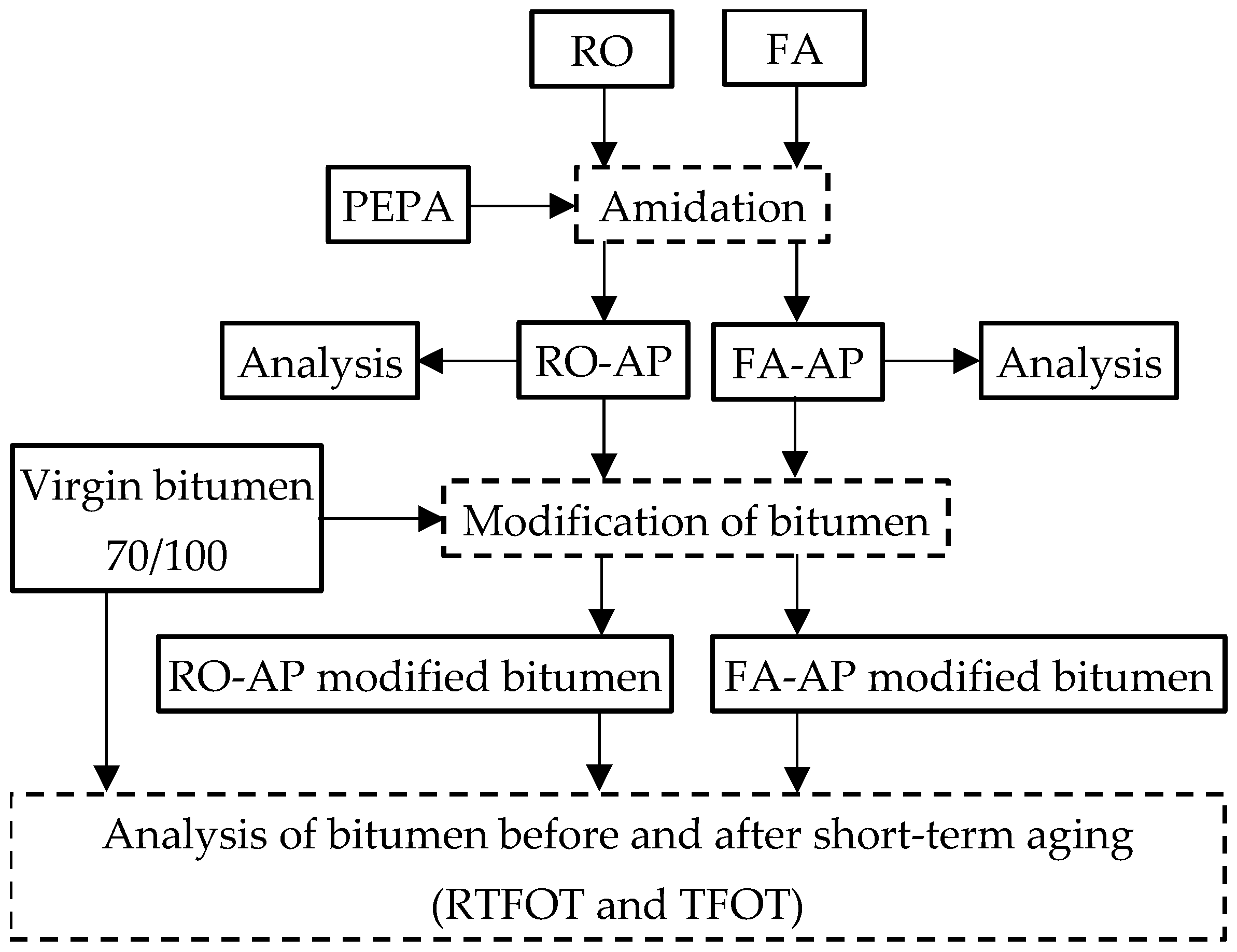



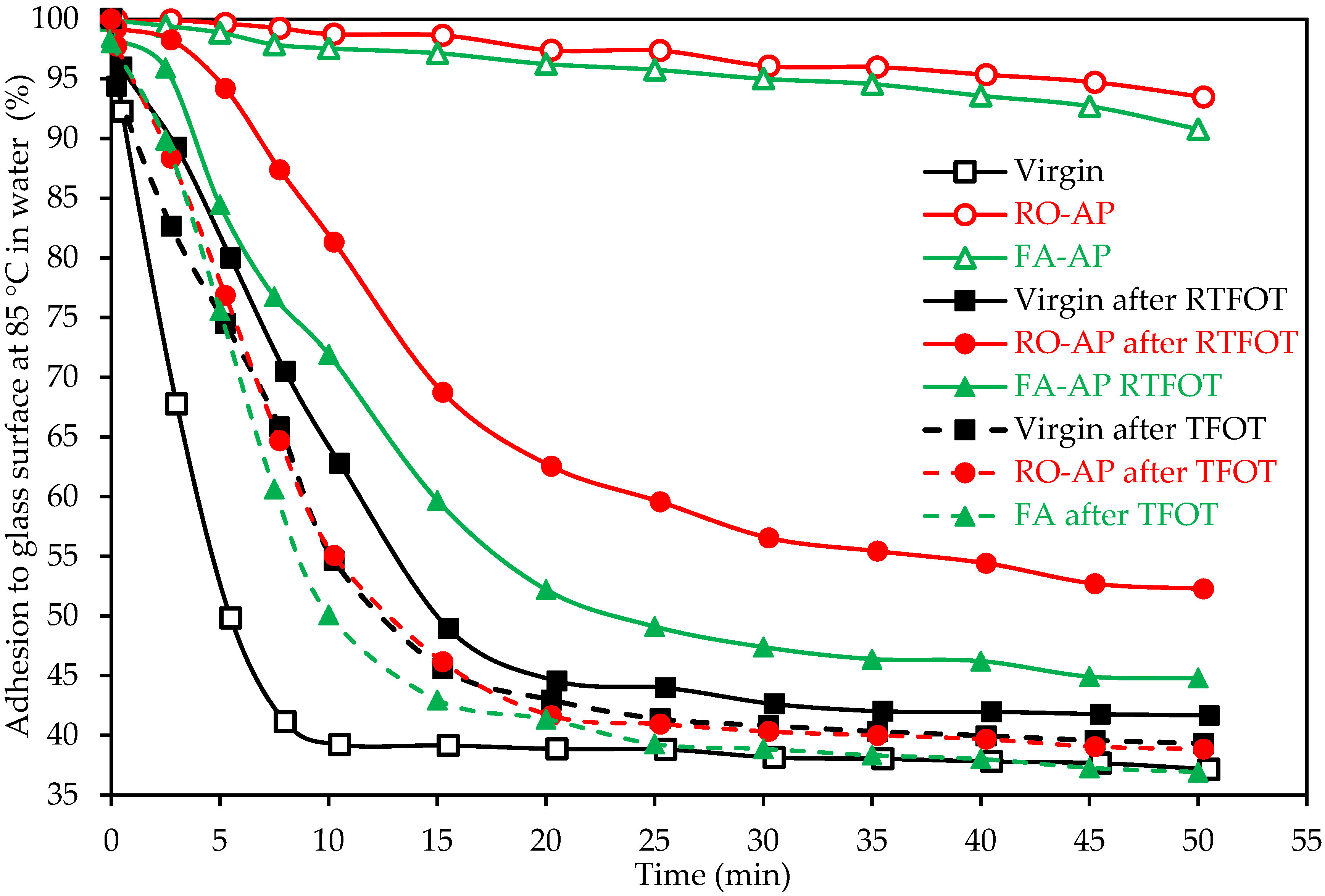
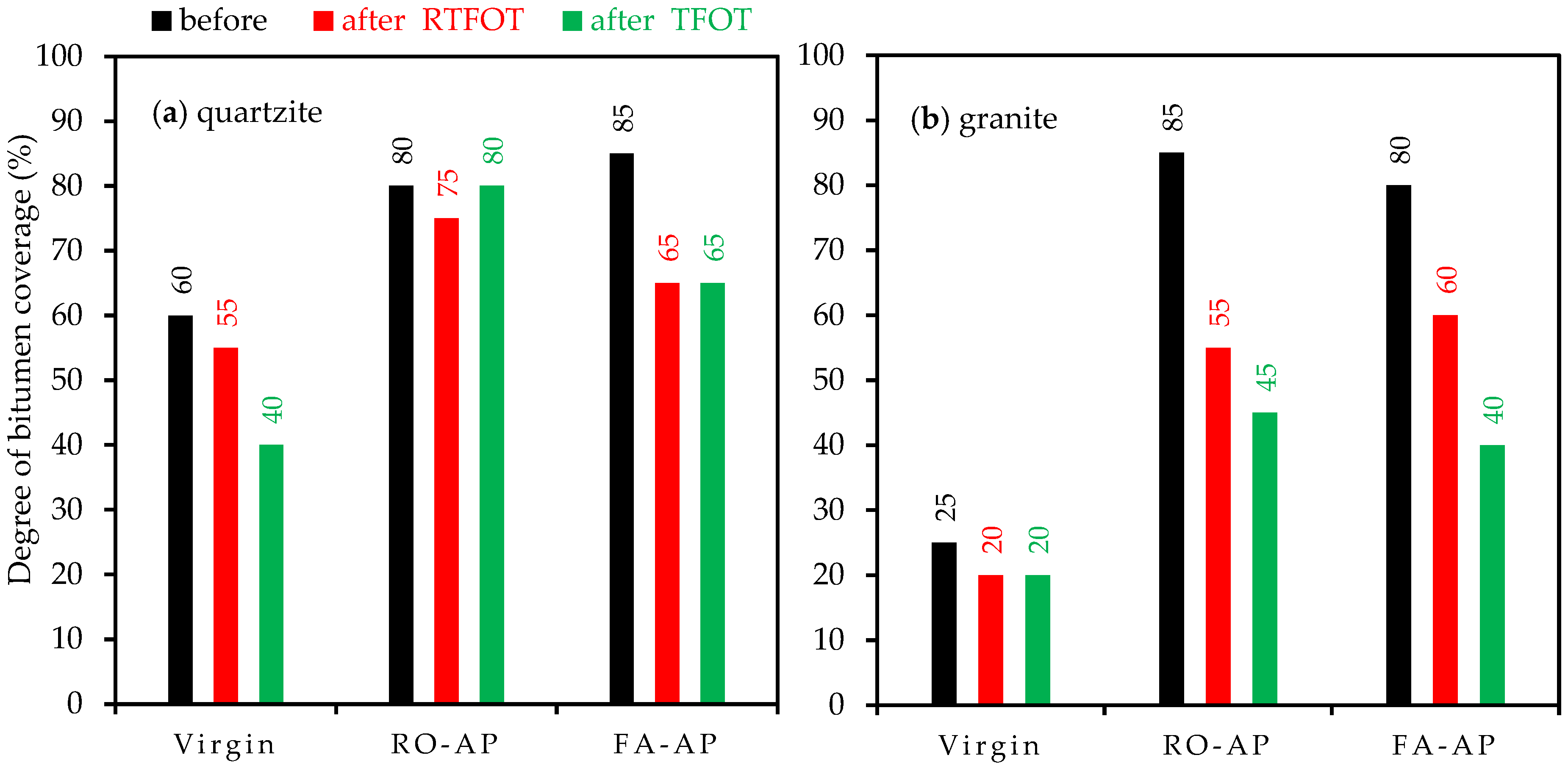
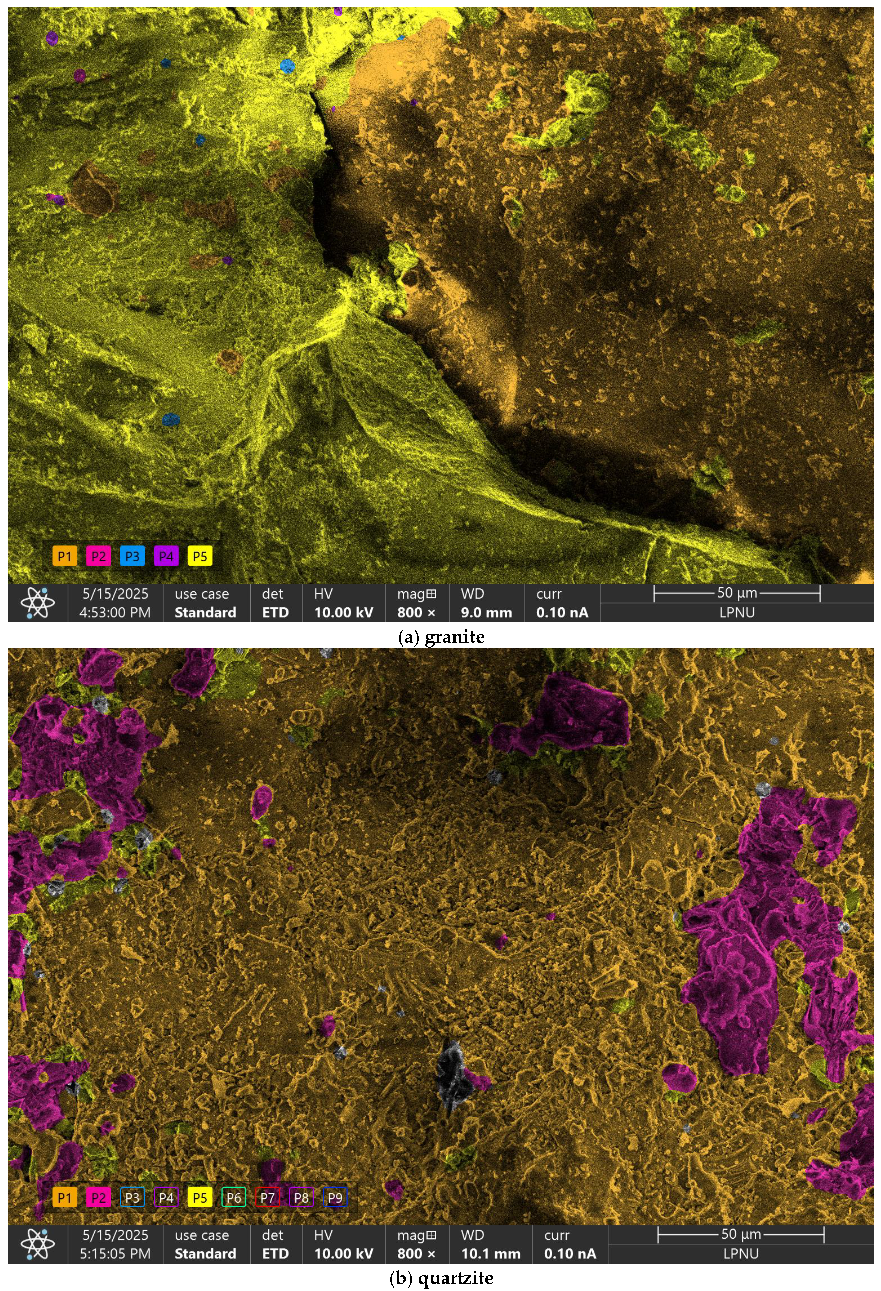
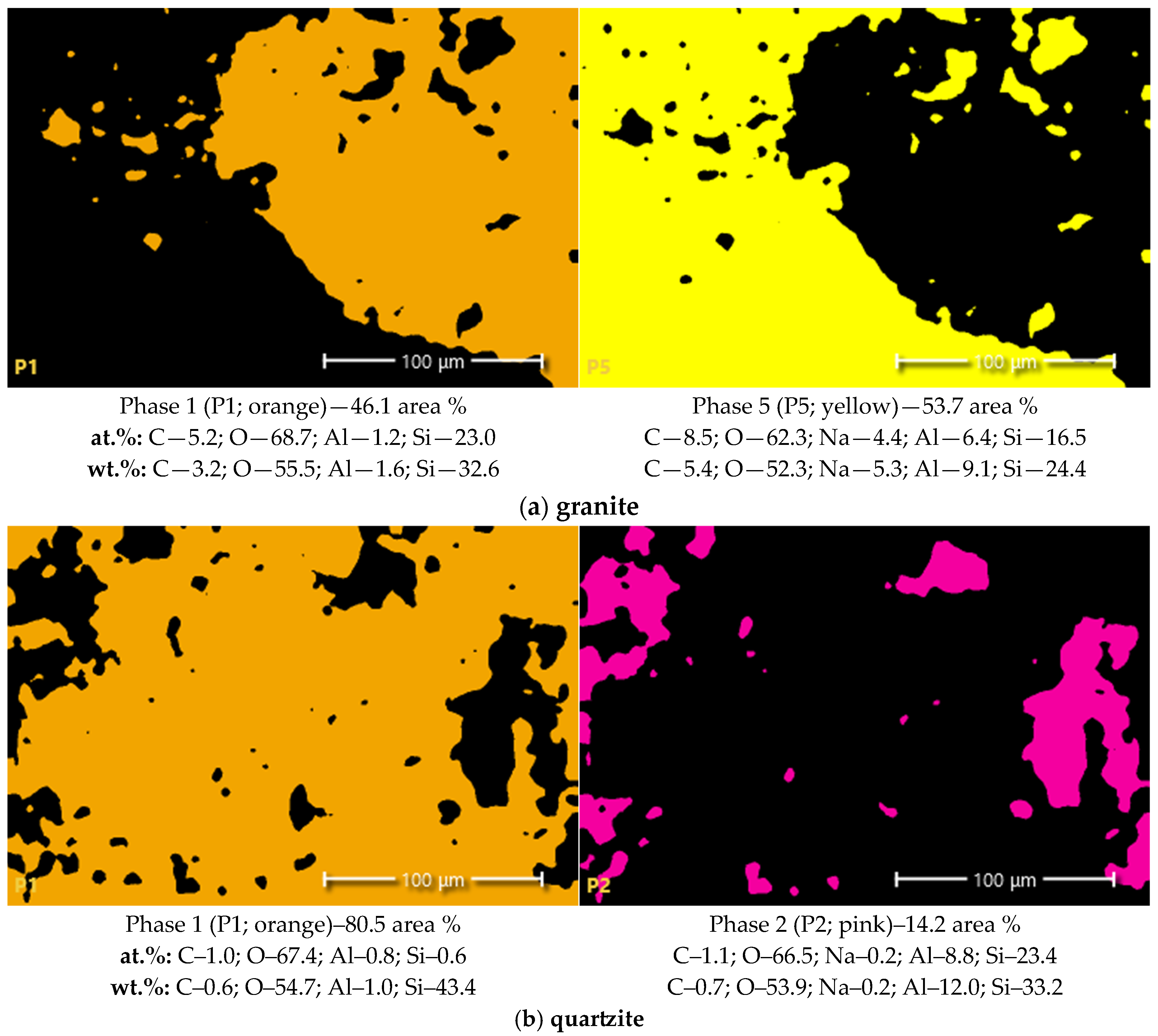
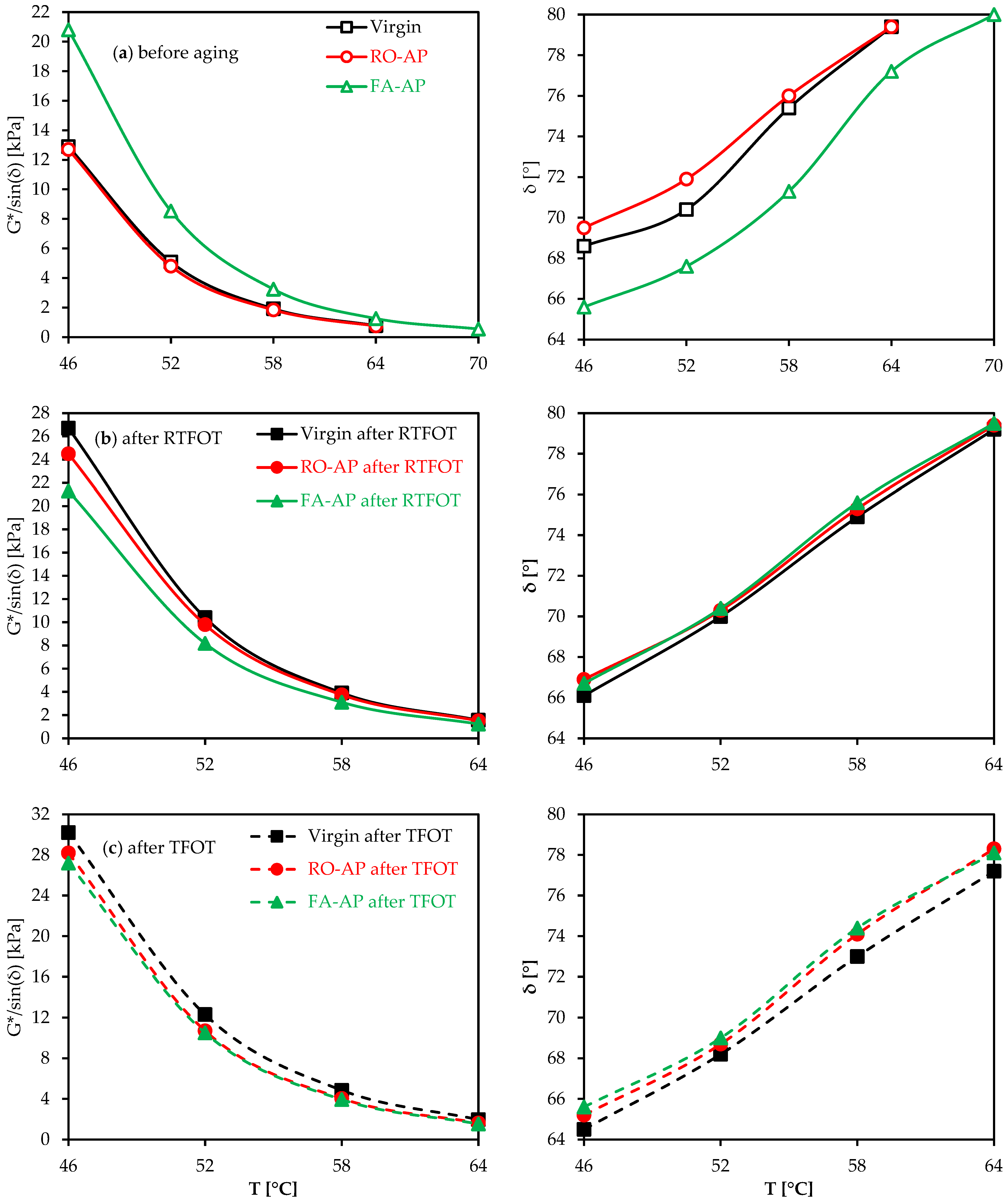
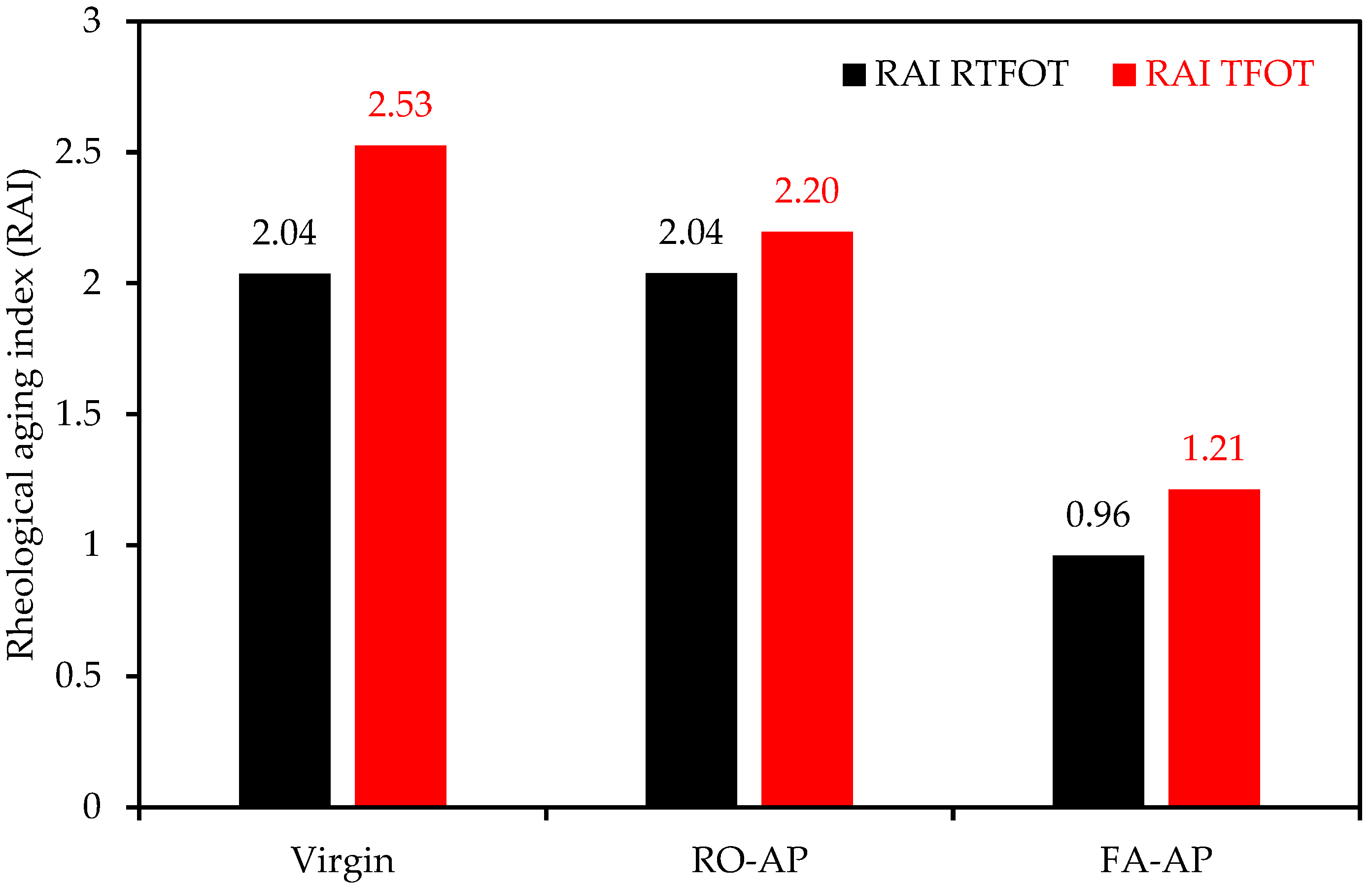
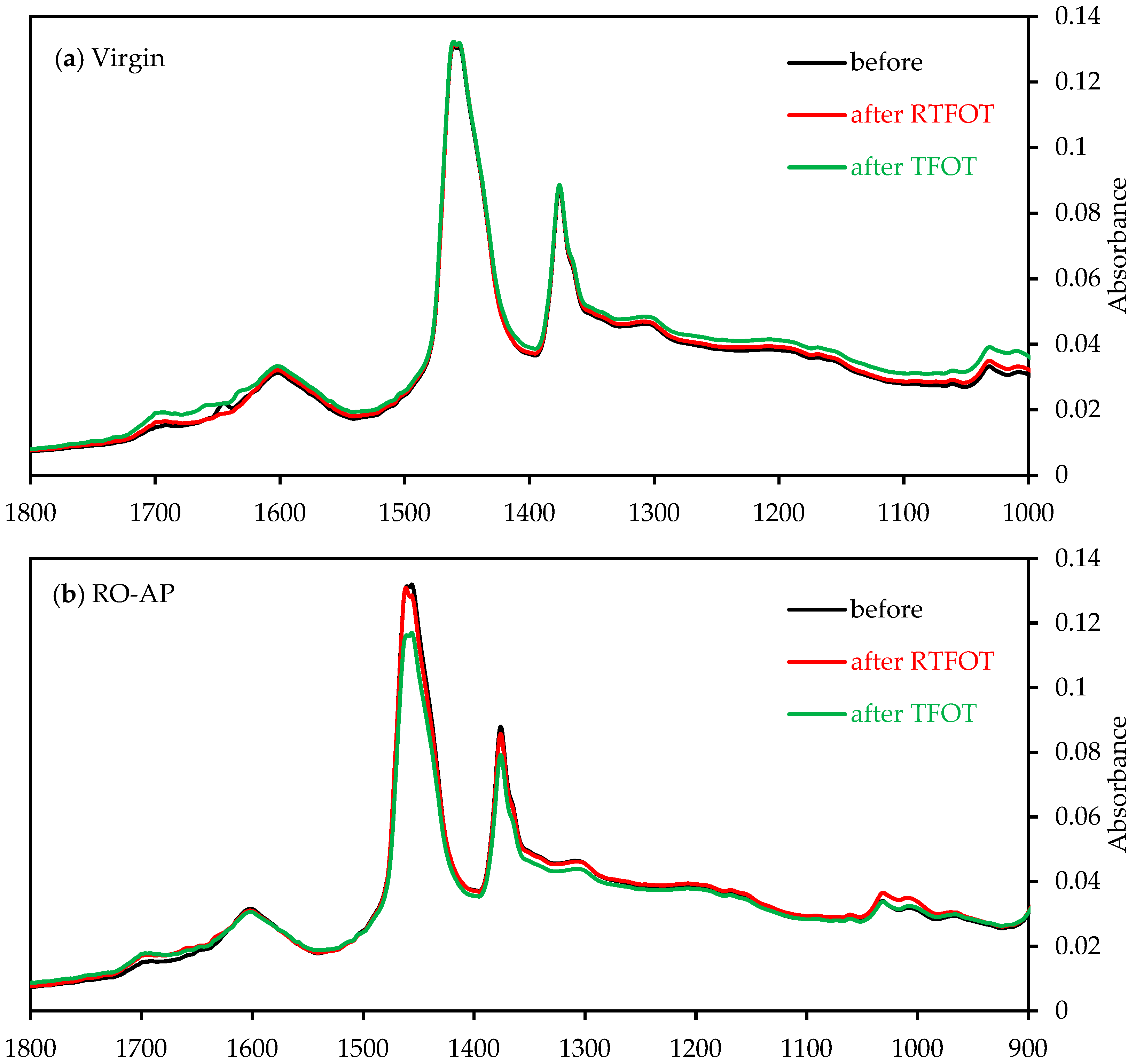
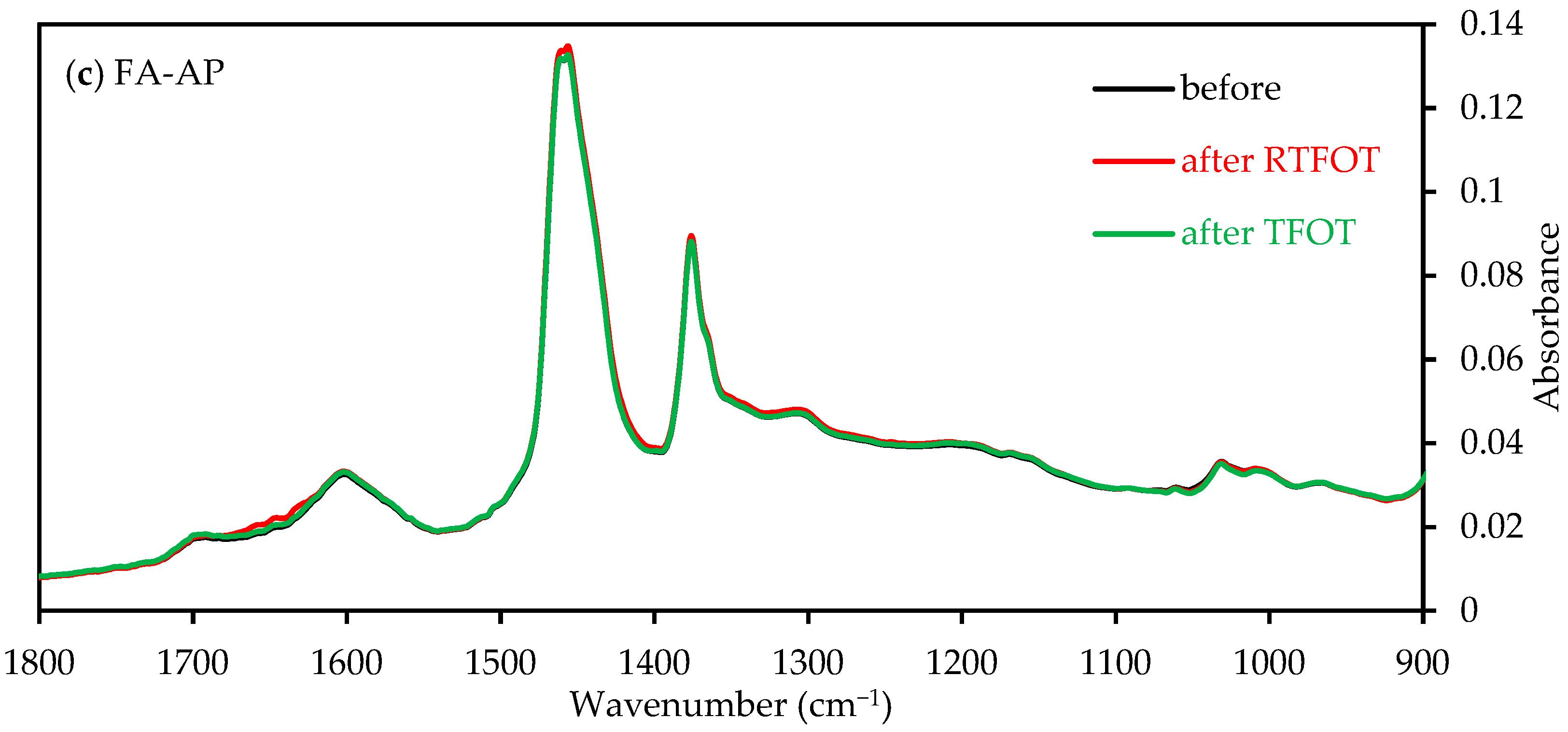

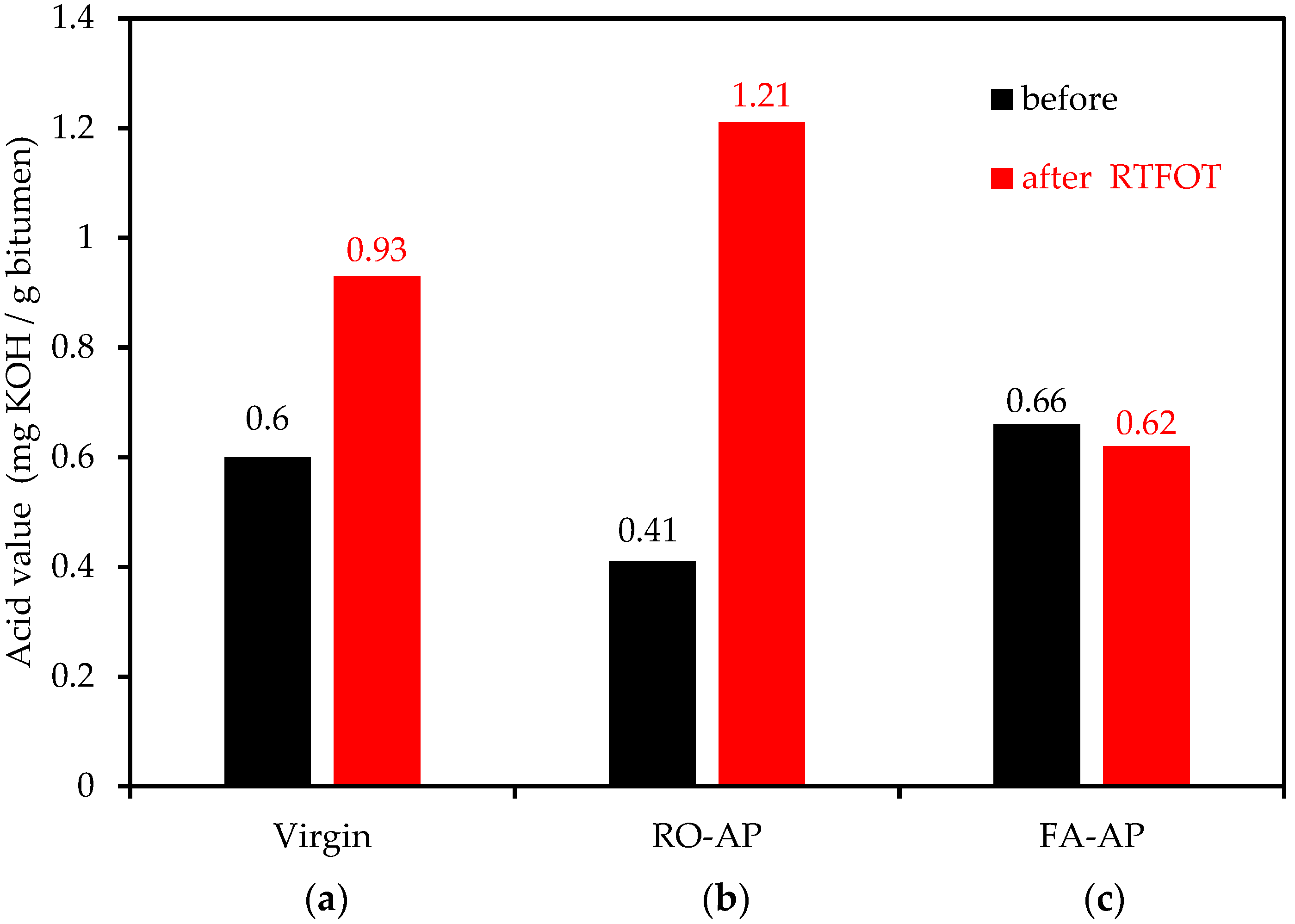
| Bio-Additive Type | Bio-Material Source | Dosage (% wt. Bitumen) | Bitumen– Aggregate | Key Findings (Adhesion) | Advantages | Disadvantages | References |
|---|---|---|---|---|---|---|---|
| Cationic amidoamine (surfactant) | Waste rapeseed oil (condensed with diethanolamine) | ~0.6–0.9 (optimum ≈ 0.9) | Penetration-grade bitumen (≈70/100); acidic (quartz) stone | Bitumen–stone wetting angle increased from 19.8° to 80.3° (much higher hydrophobicity), preventing stripping; rutting depth reduced (1.7 mm vs. 2.77 mm). | Improves binder hydrophobicity and adhesion; enhances rutting resistance; uses waste oil; no organic solvent needed. | No major disadvantages reported; long-term field performance still to be verified. | [30] |
| Plant-based oil extender (PBO) | Renewable plant oil (forest/pulp industry) | 5–30 (typically ~5–15) | Base bitumens (penetration ~80/100 and 170/200); hard crystalline granite (Sweden) | Extended binders showed higher aggregate adhesion (better coating in rolling-bottle tests and higher ITS retention), and improved long-term durability. Bitumen remained fully miscible with oil. | Carbon-neutral/petroleum-offset potential; fully miscible; improved durability and adhesion. | At high additive content, binder softening occurs (must optimize dosage); some workers noted a different odor in field trials. | [31] |
| Curcumin-based additive (turmeric) | Turmeric powder (curcuma) and purified curcumin | ~1 (tested 1–3; 1 found optimal) | Penetration 50/70 and 170/210 bitumens; acidic porphyry aggregate (porfido) | At 1% loading, refined curcumin (HPGC or RGC) nearly doubled adhesion (full coating in boiling test) vs. only ~35–40% coverage for raw turmeric. Improved bitumen–stone affinity was observed. | Natural, multi-functional (adhesion promoter + antioxidant); effective at low dosage with purified curcumin; enhanced binder–aggregate bonding. | Raw turmeric powder is less effective (requires higher dosage); cost/processing of purified curcumin may be high. | [32,33] |
| Vegetable fluxing additives | Sunflower oil esters (Oleoflux); vegetable resin (Green Seal) | 0.5–5 | 50/70 bitumen; typical aggregates (field mixes) | Adding 0.5–5% flux lowered bitumen viscosity (enabling warm-mix paving) and promoted binder–aggregate coating. Moisture resistance was maintained or slightly improved due to better wetting. | Allows warm-mix production (lower temp, energy savings) and better coating; environmentally friendly (natural oils). | Slight reduction in stripping resistance observed in WMA mixes; excessive dosage (esp. Green Seal) can over-soften binder. | [34] |
| Index | Units of Measurement | Value | Methods | Requirements According to [35] | |
|---|---|---|---|---|---|
| Penetration at | 5 °C | 0.1 mm | 5 | DSTU EN 1426:2018 [36] | - |
| 15 °C | 17 | - | |||
| 25 °C | 70 | 70 … 100 | |||
| 35 °C | 199 | - | |||
| Softening point (SP) | °C | 48.5 | DSTU EN 1427:2018 [37] | 43 … 51 | |
| Fraass breaking point (FBP) | °C | −17.5 | DSTU EN 12593:2018 [38] | ≤−10 | |
| Ductility at 25 °C (D25) | cm | 99.8 | DSTU 8825:2019 [39] | - | |
| Penetration index calculated by SP | - | −0.78 | DSTU EN 12591:2017 [35] | −1.5 … +0.7 | |
| Plasticity interval (PI = SP − FBP) | °C | 66.0 | - | ||
| Temperature at which the penetration is 800 × 0.1 mm (T800) | °C | 45.5 | - | ||
| ΔT = SP − T800 | °C | 3.0 | - | - | |
| Penetration index calculated by T800 | - | −1.63 | - | ||
| Adhesion to glass at 85 °C in water for 25 min | % | 38.8 | DSTU 9169:2021 [40] | - | |
| Temperature at which the penetration is 1.25 mm | °C | −6.0 | |||
| Resistance to hardening at 163 °C (RTFOT) | DSTU B EN 12607-1:2015 [41] | ||||
| Retained penetration at 25 °C | % | 75.7 | ≥46 | ||
| Increase in softening point | °C | 4.4 | ≤9 | ||
| Resistance to hardening at 163 °C (TFOT) | DSTU EN 12607-2:2019 [42] | ||||
| Retained penetration at 25 °C | % | 67.1 | - | ||
| Increase in softening point | °C | 4.0 | - | ||
| Acid value (AV) | 0.60 | ASTM D664 [43] | - | ||
| Parameter | Units of Measurement | Value | |
|---|---|---|---|
| RO-AP | FA-AP | ||
| Raw materials of vegetable origin | - | Rapeseed oil | Fatty acids |
| Reaction mixture | wt.% | ||
| Raw materials | 80 | ||
| PEPA | 20 | ||
| Temperature | °C | 140 | |
| Duration | h | 4.0 | |
| Peak (cm−1) | Vibration | References |
|---|---|---|
Secondary amide  | ||
| 3260 | N–H stretching | [51] |
| 1640 | C=O stretching In-plane N–H band (two bands) | |
| 1540 | ||
| 1284 | C–N stretching | |
| 691 | Out-of-plane N–H band | |
Tertiary amide  | ||
| 1640 | C=O stretching (one band) | [51] |
| Ester groups in RO | ||
| 1745 | C=O stretching | [52] |
| Fatty acid | ||
| 1708 | C=O stretching | [53] |
| Index | Units of Measurement | Virgin | RO-AP | FA-AP | |
|---|---|---|---|---|---|
| Penetration at | 5 °C | 0.1 mm | 5 | 4 | 6 |
| 15 °C | 17 | 23 | 21 | ||
| 25 °C | 70 | 65 | 69 | ||
| 35 °C | 199 | 196 | 194 | ||
| Softening point (SP) | °C | 48.5 | 49.5 | 48.9 | |
| Fraass breaking point (FBP) | °C | −17.5 | −16 | −17 | |
| Ductility at 25 °C (D25) | cm | 99.8 | 101.4 | 99.2 | |
| Penetration index calculated by SP | - | −0.78 | −0.70 | −0.71 | |
| Plasticity interval (PI = SP − FBP) | °C | 66.0 | 65.5 | 65.9 | |
| Temperature at which the penetration is 800 × 0.1 mm (T800) | °C | 45.5 | 45.0 | 46.5 | |
| ΔT = SP − T800 | °C | 3.0 | 4.5 | 2.4 | |
| Penetration index calculated by T800 | - | −1.63 | −1.96 | −1.38 | |
| Adhesion to glass at 85 °C in water for 25 min | % | 38.8 | 97.4 | 95.8 | |
| Temperature at which the penetration is 1.25 mm | °C | −6.0 | −5.5 | −8.5 | |
| Index | Units of Measurement | Virgin | RO-AP | FA-AP | ||||
|---|---|---|---|---|---|---|---|---|
| RTFOT | TFOT | RTFOT | TFOT | RTFOT | TFOT | |||
| Penetration at | 5 °C | 0.1 mm | 5 | 5 | 4 | 5 | 5 | 6 |
| 15 °C | 18 | 17 | 18 | 16 | 21 | 20 | ||
| 25 °C | 53 | 47 | 46 | 50 | 45 | 52 | ||
| 35 °C | 124 | 110 | 119 | 112 | 118 | 109 | ||
| Retained penetration at 25 °C | % | 75.7 | 67.1 | 70.8 | 76.9 | 65.2 | 75.4 | |
| Softening point (SP) | °C | 52.9 | 52.5 | 53.0 | 52.7 | 53.1 | 52.4 | |
| Increase in softening point | °C | 4.4 | 4.0 | 3.5 | 3.2 | 4.2 | 3.5 | |
| Fraass breaking point (FBP) | °C | −17.0 | −16.0 | −16.5 | −17.0 | −17.0 | −18.0 | |
| Ductility at 25 °C (D25) | cm | 55.5 | – | 49.1 | – | 49.2 | – | |
| Penetration index calculated by SP | - | −0.37 | −0.74 | −0.67 | −0.55 | −0.70 | −0.53 | |
| Plasticity interval (PI = SP − FBP) | °C | 69.9 | 68.5 | 69.5 | 69.7 | 70.1 | 70.4 | |
| Temperature at which the penetration is 800 × 0.1 mm (T800) | °C | 51.0 | 53.5 | 51.0 | 52.5 | 52.5 | 54.5 | |
| ΔT = SP − T800 | °C | 1.9 | −1.0 | 2.0 | 0.2 | 0.6 | −2.1 | |
| Penetration index calculated by T800 | - | −0.82 | −0.51 | −1.15 | −0.60 | −0.84 | −0.05 | |
| Adhesion to glass at 85 °C in water for 25 min | % | 44.0 | 41.4 | 59.6 | 40.9 | 49.1 | 39.3 | |
| Temperature at which the penetration is 1.25 mm | °C | −9.0 | −9.0 | −7.0 | −9.0 | −10.0 | −12.5 | |
| Element | Wt.% | |
|---|---|---|
| Granite | Quartzite | |
| Si | 35.4238 ± 0.0619 | 44.5820 ± 0.0302 |
| Al | 7.4730 ± 0.0769 | 2.0397 ± 0.0522 |
| K | 3.0169 ± 0.0201 | 0.0280 ± 0.0058 |
| Ca | 1.8497 ± 0.0161 | 0.0782 ± 0.0047 |
| Fe | 1.8429 ± 0.0099 | 0.2209 ± 0.0036 |
| Mg | 0.3147 ± 0.1129 | - |
| Ti | 0.2333 ± 0.0060 | 0.0725 ± 0.0037 |
| S | 0.0452 ± 0.0087 | 0.0293 ± 0.0066 |
| Sr | 0.0376 ± 0.0004 | 0.0112 ± 0.0003 |
| Mn | 0.0314 ± 0.0039 | 0.0080 ± 0.0027 |
| Zn | 0.0235 ± 0.0084 | 0.0287 ± 0.0059 |
| Element | Granite | Quartzite | ||
|---|---|---|---|---|
| At.% | Wt.% | At.% | Wt.% | |
| C | 7.1 ± 0.1 | 4.5 ± 0.0 | 1.2 ± 0.0 | 0.7 ± 0.0 |
| O | 65.0 ± 0.3 | 54.7 ± 0.3 | 67.0 ± 0.3 | 54.0 ± 0.3 |
| Na | 2.4 ± 0.0 | 2.9 ± 0.0 | - | - |
| Mg | 0.4 ± 0.0 | 0.5 ± 0.0 | - | - |
| Al | 3.7 ± 0.0 | 5.2 ± 0.0 | 1.8 ± 0.0 | 2.5 ± 0.0 |
| Si | 20.4 ± 0.1 | 30.1 ± 0.1 | 29.8 ± 0.1 | 42.2 ± 0.1 |
| K | 0.4 ± 0.0 | 0.9 ± 0.0 | - | - |
| Ca | 0.4 ± 0.0 | 0.8 ± 0.0 | - | - |
| Fe | 0.2 ± 0.1 | 0.4 ± 0.1 | 0.2 ± 0.1 | 0.6 ± 0.2 |
Disclaimer/Publisher’s Note: The statements, opinions and data contained in all publications are solely those of the individual author(s) and contributor(s) and not of MDPI and/or the editor(s). MDPI and/or the editor(s) disclaim responsibility for any injury to people or property resulting from any ideas, methods, instructions or products referred to in the content. |
© 2025 by the authors. Licensee MDPI, Basel, Switzerland. This article is an open access article distributed under the terms and conditions of the Creative Commons Attribution (CC BY) license (https://creativecommons.org/licenses/by/4.0/).
Share and Cite
Gunka, V.; Poliak, O.; Hrynchuk, Y.; Stadnik, V.; Demchuk, Y.; Besaha, K.; Galkin, A.; Pyrig, Y. Sustainable Bitumen Modification Using Bio-Based Adhesion Promoters. Sustainability 2025, 17, 7187. https://doi.org/10.3390/su17167187
Gunka V, Poliak O, Hrynchuk Y, Stadnik V, Demchuk Y, Besaha K, Galkin A, Pyrig Y. Sustainable Bitumen Modification Using Bio-Based Adhesion Promoters. Sustainability. 2025; 17(16):7187. https://doi.org/10.3390/su17167187
Chicago/Turabian StyleGunka, Volodymyr, Olha Poliak, Yurii Hrynchuk, Vitalii Stadnik, Yuriy Demchuk, Khrystyna Besaha, Andrii Galkin, and Yan Pyrig. 2025. "Sustainable Bitumen Modification Using Bio-Based Adhesion Promoters" Sustainability 17, no. 16: 7187. https://doi.org/10.3390/su17167187
APA StyleGunka, V., Poliak, O., Hrynchuk, Y., Stadnik, V., Demchuk, Y., Besaha, K., Galkin, A., & Pyrig, Y. (2025). Sustainable Bitumen Modification Using Bio-Based Adhesion Promoters. Sustainability, 17(16), 7187. https://doi.org/10.3390/su17167187









